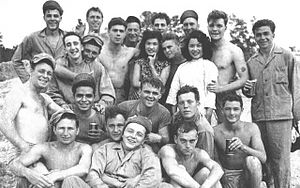Operation Beleaguer
| Operation Beleaguer | |||||||
|---|---|---|---|---|---|---|---|
| Part of the Chinese Civil War and the Cold War | |||||||
 Marines in Tsingtao during Operation Beleaguer. |
|||||||
|
|||||||
| Belligerents | |||||||
|
|
|
||||||
| Commanders and leaders | |||||||
|
|
|
||||||
| Units involved | |||||||
|
III Amphibious Corps 7th Fleet 14th Air Force |
8th Route Army | ||||||
| Strength | |||||||
| 50,000 | Unknown | ||||||
| Casualties and losses | |||||||
| 35 killed 43 wounded |
Unknown | ||||||
Successful operation:
Operation Beleaguer was a major United States military operation that took place in northeastern China's Hopeh and Shantung Provinces between 1945 and 1949. The main objectives of the operation were the repatriation of more than 600,000 Japanese and Koreans, who remained in China after the end of World War II, and the protection of American lives and property. During the course of nearly four years, American forces engaged in several small battles with the Communists, and they were successful in repatriating and evacuating thousands of foreign nationals. The United States government also attempted to mediate a peace treaty with the opposing Nationalist and Communist forces, but the effort was unsuccessful.
During World War II, China was a battlefield with three opposing armies; the government, or Nationalist forces of Chiang Kai-shek, the Communists under Mao Zedong, and the Japanese. When Japan surrendered in 1945, over 630,000 Japanese and Korean military personnel and civilians were still in China, and in need of repatriation. Since the Chinese government was not up to the task, President Harry Truman sent over 50,000 United States Marines of the III Amphibious Corps (IIIAC) and the 7th Fleet to northern China with orders to accept the surrender of the Japanese and their Korean former subjects, repatriate them, and help the Nationalists reassert their control over areas previously held by the Japanese. The Marines were not to take sides in the fighting, and were only allowed to engage in combat if fired upon first. Major General Keller E. Rockey, IIIAC, was placed in command of the operation, and Lieutenant General Albert C. Wedemeyer was in command of the China Theater.
...
Wikipedia
